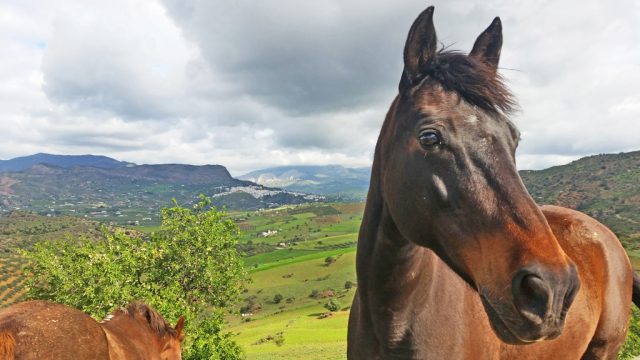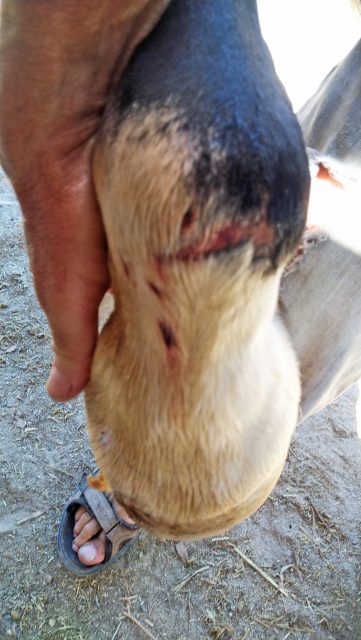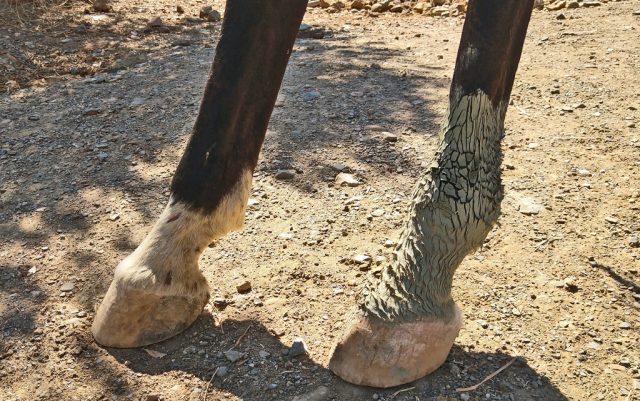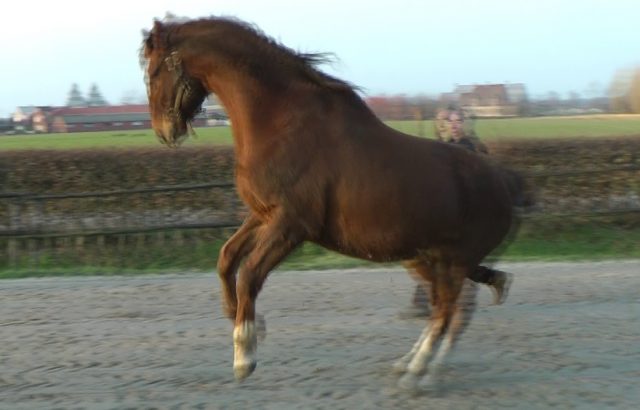 Whenever anyone tells me an extraordinary – by ordinary standards – story about their horse’s ability to understand and communicate with them in the absence of any training or trained (conditioned) behaviour, I usually encourage them to share it with other horse people. My thinking goes along these lines: the more we humans realise what is possible with horses by simply relying on understanding, trust, connection and communication, the less need we will have to reach for the crutch of training and the more we will learn to rely on authentic inter-species interaction, something which horses readily offer us, if only we would take the time to listen to them. I had just exited a Zoom meeting with fellow horse lovers from around the world yesterday afternoon, when just such another extraordinary event occurred in the most ordinary way. So to practise what I preach it seems appropriate to share it with you.
Whenever anyone tells me an extraordinary – by ordinary standards – story about their horse’s ability to understand and communicate with them in the absence of any training or trained (conditioned) behaviour, I usually encourage them to share it with other horse people. My thinking goes along these lines: the more we humans realise what is possible with horses by simply relying on understanding, trust, connection and communication, the less need we will have to reach for the crutch of training and the more we will learn to rely on authentic inter-species interaction, something which horses readily offer us, if only we would take the time to listen to them. I had just exited a Zoom meeting with fellow horse lovers from around the world yesterday afternoon, when just such another extraordinary event occurred in the most ordinary way. So to practise what I preach it seems appropriate to share it with you.
In the course of our Zoom meeting our discussions also led us to address the questions of ‘To ride or not to ride?’ and ‘To train or not to train?’. Leaving aside the first question for the time being, perhaps the most frequently cited reason for training horses is that we need to do so in order to teach them how to negotiate the parameters of domesticated life. For instance, they need to learn how to accept a halter, to respond counter-intuitively to pressure on the lead rope by acceding to rather than resisting it, to stand calmly while having their hooves cared for or to receive medical or dental attention, and so forth. And yes, horses are trained to do this and in general they subsequently behave accordingly when requested to do so in the manner that they have been taught, although I must confess that it sometimes looks as though the training is starting all over again when the human demands the trained behaviour.
Over the years horses have led me to question the wisdom of this supposedly self-obvious principle of horse care to the point where I have largely abandoned it for little reason other than that in most, if not all, cases such training and its results have shown themselves to be utterly unnecessary. Actually, let me correct this. It is the horses themselves that have shown me how superfluous they are. In the course of writing this blog, I have already covered a number of instances when this has occurred. Here is another of those lessons, this time courtesy of our former mistress of resistance, Anaïs.
Wound cleaning and dressing at liberty 1
Just after our virtual meeting ended yesterday afternoon, Vicki alerted me to the fact that Anaïs had injured herself. Apparently, she must have slipped on the rocks while hunting for carob beans up on the hill, for she had cut herself open on the coronet band, pastern and fetlock of her left hind leg. Armed with a small basin of water, some gauze and iodine, I crouched down to clean and dress the wounds. The mare responded by raising her foot and allowing me to rest it on my knee, which was easier for both of us.
The wounds appeared to be largely superficial, although I was a bit concerned about the one on the coronet band because, being so close to the ground, it was easily covered with whatever lay on the ground where the horse walked. It was also the wound which seemed to be the most sensitive of the lot. Still, even though she flinched at times, Anaïs allowed me to clean and dress her wounds without any difficulty.
All of this occurred at liberty and had not been preceded by any conscious training on my part. Neither was there any consciously trained behaviour which I could call on the mare to reproduce with the aid of a cue.
Wound cleaning and dressing at liberty 2
This morning after tending to the horses and feeding them, which included cleaning and dressing Anaïs’ carob-hunting wounds again, Vicki and I returned to the house to have breakfast. There we discussed whether we should do anything else about the wounds, because we had noticed the development of some swelling, especially around the fetlock. It was decided that I would dress all of Anaïs’ wounds with green clay to reduce the swelling and keep out the dirt while the initial healing occurred.
When I returned to the field to do this, Anaïs was just on her way out, presumably to do some foraging. With my hands full, I could only manage to call her name and tell her that I needed to put some clay on her wounds. So what did the mare do? Simply the most logical thing as far as I was concerned, albeit that I would not have thought this several years ago. Anaïs simply stopped, looked back at me, turned around and approached the area in front of the walk-in, walk-out stables, where she again lifted her foot onto my knee to allow me to clean her wounds. Afterwards she walked into one of the stables and waited while I mixed the clay.
This time I explained to Anaïs that she needed to keep her foot on the floor while I applied the clay. The mare simply did what I asked and stood completely still while I applied the clay from above the fetlock down to the coronet band. When I finished, I thanked her and told her she could go now. So she did. Again, none of this had been preceded by any conscious training on my part. Neither was there any consciously trained behaviour which I could call on the mare to reproduce with the aid of a cue.
The extraordinary becomes ordinary
Now all of this is utterly ordinary behaviour on the part of a creature that understands, trusts and is capable of connecting and communicating with a human. Several years ago though I would have considered it to be absolutely extraordinary, for that understanding, trust, connection and communication were absent from my relations with horses. The abnormal was normal and the ordinary had become extraordinary. Training was the way to go and to this extent it became the measure of my impotence. The more powerless I was before the horse, the more training I felt the horse required. So it goes….
Then, as time passed and my self-development proceeded, what had become extraordinary started to become ordinary. I would find myself asking my mare, Pip, to move over while grooming her and was initially astounded when she did. It is not that I believe she understood my words but that what I said influenced my energy. After watching horses do this, I had started to rely more on energetical communication with them as an accompaniment to body language, because it seemed to be far more effective to do so. Then I began to sense that my words helped me to express my intent, which was reflected in my energy.
This developed to the extent that I found that the horses allowed me to use energetical communication instead of the conventional cues. When using a halter, there was usually no need to tug on the lead rope to initiate or accelerate movement. Raising and directing my energy through a relatively slight but clear movement of my body was enough. Dropping my energy level had the reverse effect. Over time communication replaced trained behaviour. This is not to say that the horses did not learn anything. They did and I could notice it, especially where ritual behaviour was involved. But that was their affair and not mine. They learned various things but without me consciously training them and very often what they learned amounted to little more than contextual clues. The extraordinary became ordinary in the absence of training.
To do or not to do?
I am not too sure that questions such as ‘To train or not to train?’ or ‘To ride or not to ride?’ are very helpful. Indeed, I suspect that they create unnecessary barriers for they imply a duality of being which is essentially utterly alien to the nature of being. They suggest that humans consist of an intellect and an implementer with the former formulating rules and guidelines and the latter implementing them unquestioningly. Cogito ergo sum! (I think, therefore I am!) Intuition and spontaneity are eradicated and the experiential is rendered redundant. In this way such questions erect a barricade between us and our ability to approach each evolving situation as it is rather than as it should be. Why bother to answer questions such as these? Why not simply respond intuitively to the particular circumstances of the situation as they present themselves?
In addition, such questions erect barriers between humans. If we insist on training, we alienate those who oppose it, and vice versa. The same goes for riding. There may be grounds for training in a particular situation, as there may be for riding. Do we really have to decide now for all time and all circumstances, even those that we cannot foresee, what our response is going to be to such a question? And are we really sure that the questions are appropriate? Do they really reflect the presence of a human who is as mindful of the evolving situation in which they find themselves as a fully present being should be?
Equine Touch
Our Equine Touch business is called Humans for Horses, you can find our website at:
http://www.humansforhorses.com/
and our Facebook page at:
https://www.facebook.com/Humans.for.Horses
Horses and Humans on Facebook
May I remind you that we now have a Horses and Humans group on Facebook. If you would like to leave a comment, you can do so on this blog or on the the Horses and Humans Facebook group page. All new posts will feature on that page along with additional content posted by any of our members. Please feel free to join us at:
https://www.facebook.com/groups/horsesandhumans/
There is also a Horses and Humans publications page, which contains information concerning the publications released under the Horses and Humans imprint. Some of those publications will be free of charge. You will find it here:
https://www.facebook.com/horsesandhumans
I also have a Facebook page through which you may contact me. You will find it at:
https://www.facebook.com/andrewglynsmail






